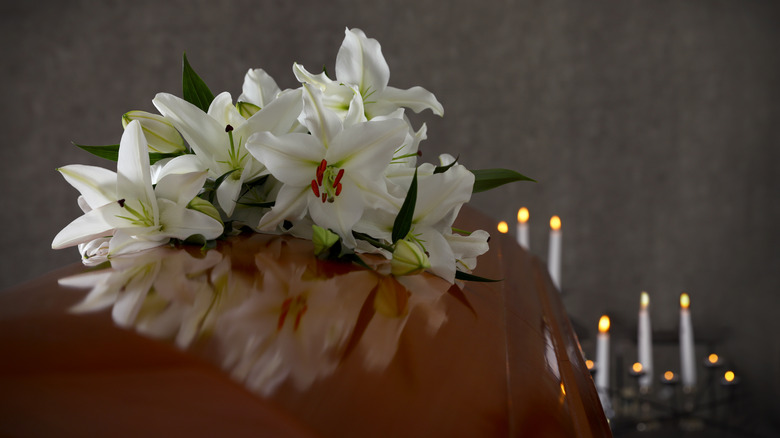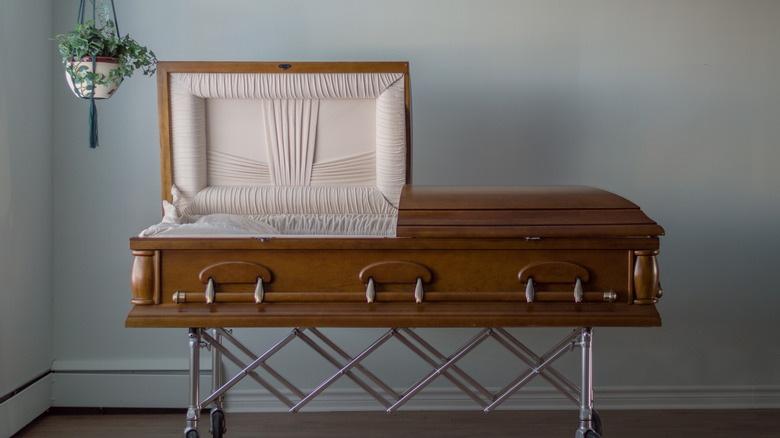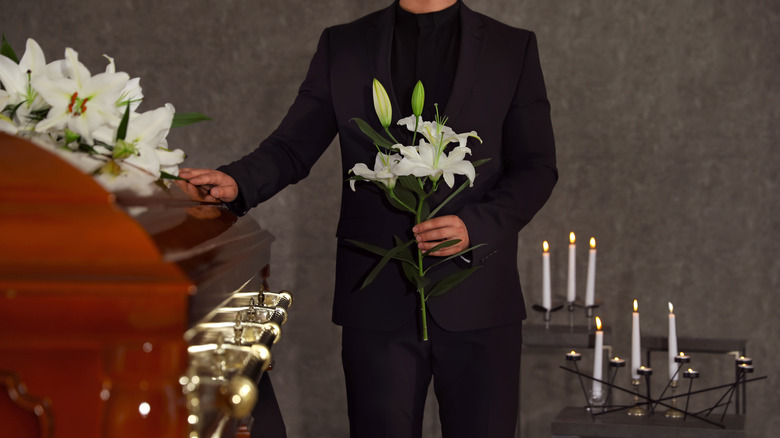Why Only The Upper Half Of The Deceased Is Usually Shown For An Open Casket Viewing
The subject of death is not something many people like to think about. However, there are those who choose to be prepared when the time comes to leave this world, and some may not realize that there are plenty of options to choose from, such as the type of casket to use. There are wooden caskets and metal caskets that are made from different materials. There's also an option to use a biodegradable casket, which is ideal for those who want a green funeral. They come in various colors, too, as noted by Remembrance Process. As noted by the Federal Trade Commission, the casket is the most expensive expense for a traditional funeral, and depending on the type chosen, it can cost about $2,000 to as much as $10,000. Another thing to consider when choosing a casket is whether to use a full-couch or a half-couch casket.
A half-couch casket has two openings on the lid that are hinged together, and when used for viewings, only the upper half is left open. This allows mourners to focus only on the upper portion of the deceased, particularly the face. On the other hand, a full-couch casket only has one lid, which leaves the whole body fully exposed during viewings (via Trusted Caskets). That's the only difference between the two, but today, the more commonly used type is the half-couch casket, but is there a particular reason why the legs of the deceased remain covered?
The common reasons for using a half-couch casket
One of the reasons why people choose a half-couch casket over a full-couch casket is because of costs and efficiency. When the full body is going to be displayed, the mortician takes more time to ensure that the deceased — from the head to the feet — looks presentable. For a half-body viewing, however, the upper half is given more attention, as noted by After Your Time. There is not much difference in price when it comes to the casket itself, but families can save money on body care and preparation costs for half-body viewings. This does not in any way mean that the lower part of the body is neglected; the legs are still prepared but more attention is given to the face and torso.
Most funeral directors suggest a half-body viewing as well, as it puts the focus on the face of the deceased, which is the part of the body that is most commonly associated with a person. The face is what visitors typically like to look at during a wake while saying their final goodbyes, and covering the lower half of the body eliminates distractions. Additionally, according to Titan Casket, funeral directors find it easier to set up the proper lighting for the viewing when only the upper half is exposed.
Another reason why half-couch caskets are used is the cause of death. In the event that the person died tragically where the lower half isn't presentable, it's best to leave it hidden from the view of mourners.
The decision is up to the family
Although half-couch caskets are more common than full-couch caskets, the decision of choosing which one to use ultimately rests on the instructions from the deceased or the immediate family members. As reported by In Valhalla, there are some regions on the East Coast where full-couch caskets are more popular than half-couch caskets. Others tend to opt for a full-couch casket in closed-casket viewings as well since the lid won't be opened anyway. The choice to have some or all parts of the deceased's body covered may also be influenced by the person's religion. For instance, as noted by Ever Plans, Jews and Muslims generally don't hold viewings for their deceased loved ones before the funeral.
There is no real explanation for why half-couch caskets are more common today. According to the Funeral Help Center, half-couch caskets may have risen in popularity in the 20th century when open-casket wakes became common and funeral parlors became more prevalent. Before that, coffins — which have six sides and a wider top — were more commonly used. That changed when the U.S. slowly shied away from British traditions, and by the 20th century, caskets had replaced coffins. Back then, the family of the deceased was responsible for all the preparations, and wakes were typically held at home. Funeral homes later became popular in order to allow the family time to properly grieve without having to worry about organizing a funeral (via Funeral Wise). As the funeral business grew, more options — such as the types of caskets — became available.


